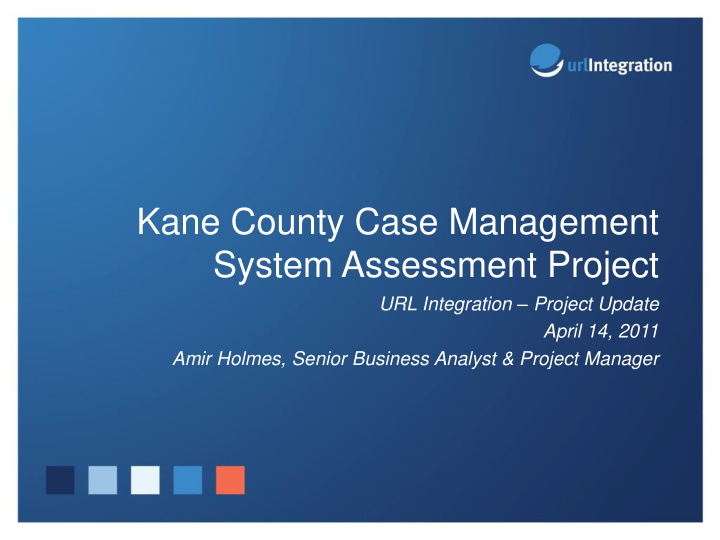



Kane County Case Management System Assessment Project URL Integration – Project Update April 14, 2011 Amir Holmes, Senior Business Analyst & Project Manager
Presentation Overview • Review of Original Project Goals & Tasks • Status of Project to Date • What Has Been Accomplished • What is Left to Be Done • Revised Timelines • Progress Against Payment Milestones • How Current Project Positions Kane County for the Future
Defining the Case Management Challenge REVIEW OF ORIGINAL PROJECT GOALS & OBJECTIVES
Review of Original Project Goals & Objectives “The County of Kane is currently using a case management system that is in its ninth year of service and various stakeholders have determined that the best course of action is to replace the system with one or more products that more closely meet the agencies’ requirements…[the goal of this project is] to assist with the review, analysis, and recommendations regarding the County’s case management systems…to facilitate, review, analyze, and recommend potential guidelines, standards, and a course of action to the Task Force.” -RFP 26-010 Technology Consultant, Case Management System, April 26, 2010
Review of Original Project Goals & Objectives • In achieving this goal, the County set forth several objectives, including: • Understanding and documenting current technology infrastructure as well as future needs, such as standards, backup/disaster recovery, and data conversion • Develop an understanding of agency case management system requirements, as well as information flow between agencies, and opportunities for process improvement • Financial analysis of the cost of new system(s) and integration, over three and five years, as well as a return on investment • Document in a blueprint that provides specific short- and long- term steps and priorities for achieving case management goals and integration
Review of Original Project Goals & Objectives What Are the Expected Outcomes of the Project? • A shared, practical understanding among stakeholders about what case management is and what it will be in Kane County • Actionable, specific work products, reports, and artifacts that provide a blueprint and direction to Kane County for case management system requirements and the implementation of integrated justice -Summary of As Is Business -Gap Analysis, BPR -Summary of As Is Technical Environment Recommendations Environment -Exchange/Workflow Analysis -Documented Functional -Summary of To Be Case Requirements for Case Management/Integration Management Architecture • Financial analysis to project and justify cost of case management and integration project
A Summary of Our Accomplishments & Plans STATUS OF PROJECT TO DATE
What Has Been Accomplished • Individual Agency Meetings – December - March • Court Services • Circuit Court Clerk • Judiciary • State’s Attorney • Public Defender • Sheriff • County IT • Exchange Analysis Meetings • First Meeting this week – April 12 – 13 • Second Meeting next week – April 19 – 20 • Final Meeting 1 st week of May – May 3 – 4
What Is Left to Be Done • Provide Analysis of Agency Meetings & Exchange Sessions • Document Requirements for RFP • Create Information Sharing Architecture & Best Practices for Kane County • Develop Return on Investment Document
Revised Timelines Task Start Date End Date Kane County CMS Assessment Project October 28, 2010 July 1, 2011 Project Planning & Kickoff October 28, 2010 January 27, 2011 Business Requirements Review, Analysis and Recommendations November 29, 2010 June 7, 2011 Review of Current Business Process and Functions December 20, 2010 March 15, 2011 Identify Integration and Interoperability Opportunities March 28, 2011 May 18, 2011 Develop Business Requirements for IT Solution May 12, 2011 June 7, 2011 Technology Review, Analysis, and Recommendations April 18, 2011 June 7, 2011 Conduct Assessment of Existing Technology April 18, 2011 May 13, 2011 Developing a "To Be" Technical Environment May 13, 2011 June 7, 2011 Financial Requirements Review, Analysis, and Recommendations May 2, 2011 June 13, 2011 Identify Current Operating Costs May 2, 2011 May 15, 2011 Identify Proposed Costs for "To Be" Business and Technical Environment May 16, 2011 June 13, 2011 Final Report June 15, 2011 July 1, 2011
Progress Against Payment Milestones Contract Invoice Deliverable Amount Actual/Projected Invoice Date Date October 31 Project Kickoff $6,654.16 January 18, 2011 November 30 Agency SME/IT $17,955.18 April 8, 2011 Meetings December 31 - - January 31 Exchange Analysis $34,186.24 May 31, 2011 Meetings & Summary Report February 28 CMS Business $27,210.30 June 30, 2011 Requirements; Technology Review & Architecture Development March 31 - - April 30 Financial Analysis and $50,585.04 July 31, 2011 3- and 5-Year Cost Projections Total $136,590.92
Understanding Cross Agency Workflow & Information Exchange LEVERAGING OUTCOMES FOR COUNTYWIDE INFORMATION SHARING
Leveraging Outcomes – Exchange Methodology • Methodology for capturing system “inputs” and “outputs” – information sharing between systems – is based on sound and proven concepts (JIEM) • While the JIEM methodology is grounded in justice, the concepts for mapping across agency information sharing can be used for other disciplines • Process elicits information about gaps in workflow between agencies and opportunities for business process re-engineering • Helps ensure that a bad process is not automated
Leveraging Outcomes - Architecture • Architectural recommendations will be driven by open technologies, such as Service Oriented Architecture (SOA) and Web Services • This architecture allows flexible agency legacy system autonomy rather than brittle point-to-point interfaces that break any time a legacy system changes or upgrades • These are general best practices in technology that form the basis of the current justice standards
Leveraging Outcomes – Product Awareness • Process of identifying court case management system functionality can be leveraged in other areas that require case management (County Clerk and Recorder, Health, etc.) • RFP process will help identify existing functionality and features offered by commercial, off-the-shelf (COTS) products
Recommend
More recommend